| dc.contributor.author | Freitas, Heverson Renan de | |
| dc.date.accessioned | 2018-05-14T23:40:25Z | |
| dc.date.available | 2018-05-14T23:40:25Z | |
| dc.date.issued | 2012-11-21 | |
| dc.identifier.citation | FREITAS, Heverson Renan de. Estudo mecanístico de reações de estado sólido: o caso do sistema Pb/PbSO4/Na2SO4. 2012. Dissertação (Mestrado em Química) – Universidade Federal de São Carlos, São Carlos, 2012. Disponível em: https://repositorio.ufscar.br/handle/ufscar/10010. | * |
| dc.identifier.uri | https://repositorio.ufscar.br/handle/ufscar/10010 | |
| dc.description.abstract | In this work, the growth and reduction of PbSO4 in Na2SO4 solution under transient conditions was characterized. A novel methodology for the working-electrode surface preparation before stabilization enhanced the voltametric measurements reproducibility. It was demonstrated a nucleation process during the growth first steps. It is suggested a new mechanism for the film growth by injection of non recombining point defects. On the other hand, the reduction occurs by injection of recombining point defects. It was demonstrated the validity of the Tafel equation for characterization of the metal/film interface and the ohmic model for the film. It was determined the Flade potential for the system Pb/PbSO4/Na2SO4. From the linear region on the Tafel plot, it was possible to determine the charge transfer coefficient and the exchange current density of the reaction Pb2+(metal)/Pb2+(film) at the Pb/PbSO4 interface. The ionic resistivity of the film was calculated versus the film thickness and the sweep rate during the transient. The disruption, which is the partial rupture of the passivation film into nanometric particles, was also analyzed. The anodic and cathodic charges determined here showed that the disruption does not occur when there is no potentiostatic aging of the film. Variation of the solution internal potential also does not affect the passivation film stability. However, when the film is subjected to a potentiostatic aging step after the voltammetric growth, if the cathodic sweep rate is bigger than the anodic one, the disruption can reach 10% of the total anodic charge, depending on reduction rate. Those aspects are different from what happens in the Pb/H2SO4 system, for which the disruption process can reach 60% of the film. | eng |
| dc.description.sponsorship | Conselho Nacional de Desenvolvimento Científico e Tecnológico (CNPq) | por |
| dc.language.iso | por | por |
| dc.publisher | Universidade Federal de São Carlos | por |
| dc.rights.uri | Acesso aberto | por |
| dc.subject | Baterias de chumbo-ácido | por |
| dc.subject | Chumbo | por |
| dc.subject | Filmes de passivação | por |
| dc.subject | Reação de estado sólido | por |
| dc.subject | Placa negativa | por |
| dc.subject | Lead-acid battery | eng |
| dc.subject | Lead | eng |
| dc.subject | Passivation films | eng |
| dc.subject | Solid state reactions | eng |
| dc.subject | Negative plate | eng |
| dc.title | Estudo mecanístico de reações de estado sólido: o caso do sistema Pb/PbSO4/Na2SO4 | por |
| dc.title.alternative | Mechanistic study of solid state reactions: the case of the Pb/PbSO4/Na2SO4 system | eng |
| dc.type | Dissertação | por |
| dc.contributor.advisor1 | D'Alkaine, Carlos Ventura | |
| dc.contributor.advisor1Lattes | http://lattes.cnpq.br/8699821828310072 | por |
| dc.description.resumo | Neste trabalho, caracteriza-se, por reações de estado sólido, o crescimento e a redução de PbSO4 sobre Pb em solução de Na2SO4 sob condições transientes. Um novo método de preparação da superfície do eletrodo de trabalho antes da estabilização permitiu uma melhora da reprodutibilidade nas medidas voltamétricas. A nucleação durante os primeiros estágios de crescimento foi demonstrada. Propõe-se um novo mecanismo para o crescimento do filme através da injeção de defeitos pontuais não recombinantes. A redução, por sua vez, se dá pela injeção de defeitos pontuais recombinantes. Demonstrou-se a validade da equação de Tafel para caracterização da interface metal/filme e o modelo ôhmico para o filme. As análises permitiram a determinação do potencial de Flade do sistema Pb/PbSO4/Na2SO4 além do coeficiente de transferência e a densidade de corrente de troca da reação Pb2+(metal)/Pb2+(filme), na interface Pb/PbSO4. Em relação ao filme, foi determinada, durante o transiente, sua resistividade iônica em função da velocidade de varredura e de sua espessura. A dirupção (ruptura parcial do filme de passivação em partículas nanométricas) também foi analisada. Determinações de cargas anódicas e catódicas mostraram que a dirupção não ocorre quando não há envelhecimento potenciostático do filme. A variação do potencial interno da solução também não afeta a estabilidade do filme de passivação. Porém, quando o filme é sujeito a um envelhecimento potenciostático após o crescimento voltamétrico, se a velocidade de varredura catódica é maior que a de crescimento, ocorre uma pequena taxa de dirupção de até 10%, dependendo da taxa de redução. Estes aspectos são diferentes do que ocorre para o sistema Pb/H2SO4, no qual o fenômeno de dirupção chega a ser da ordem de 60%. | por |
| dc.publisher.initials | UFSCar | por |
| dc.publisher.program | Programa de Pós-Graduação em Química - PPGQ | por |
| dc.subject.cnpq | CIENCIAS EXATAS E DA TERRA::QUIMICA::FISICO-QUIMICA::CINETICA QUIMICA E CATALISE | por |
| dc.subject.cnpq | CIENCIAS EXATAS E DA TERRA::QUIMICA::FISICO-QUIMICA::ELETROQUIMICA | por |
| dc.subject.cnpq | CIENCIAS EXATAS E DA TERRA::QUIMICA::FISICO-QUIMICA | por |
| dc.description.sponsorshipId | CNPq: 136839/2010-0 | por |
| dc.ufscar.embargo | Online | por |
| dc.publisher.address | Câmpus São Carlos | por |
| dc.contributor.authorlattes | http://lattes.cnpq.br/8829870766609044 | por |
